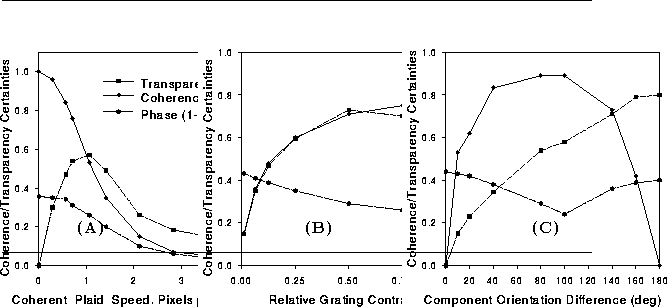


Next:
5 Results and Discussion
Up:
Degenerate Models of Additive
Previous:
3 An Artificial Neural
Our experiments are based upon moving plaid patterns, like the ones
shown in figure 1. To these images we manipulated relative grating
speed, contrast and orientation. We calculated each model's certainty
measurement following the example given by equation (
21
) for a phase (1-d), coherent, and transparent velocity. The
pre-processing filters were Difference of Gaussian (DoG) smoothing
kernels and their first and second order derivatives. Two different DoG
filters were used with peak tuning frequencies that were two octaves
apart. The magnitude of the Lagrange multiplier used to stabilize the
transparent model (equations (7) and (8)) was unity. Lagrange
multipliers were omitted for the phase (1-d) and coherent models.

Figure 3:
Motion certainties for coherence, additive transparency and phase (1-d)
velocity.
We varied:
(A)
: Image speed. The two sinusoidal gratings were equal in contrast and
orthogonal in spatial orientation.
(B)
: Relative grating contrast. The coherent velocity was fixed at 0.707
pixels per frame. The two gratings were orthogonal in spatial
orientation.
(C)
: Relative orientation. The magnitude of spatial frequency and temporal
frequency was fixed. The grating's speed was also fixed at 0.3 pixels
per frame. For these experiments each grating's spatial frequency
differed by 2 octaves.



Next:
5 Results and Discussion
Up:
Degenerate Models of Additive
Previous:
3 An Artificial Neural
Adrian F Clark
Tue Jul 22 15:38:58 BST 1997



